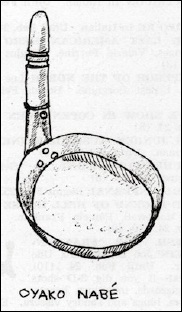with Elizabeth Andoh
Ricе is very important to the Japanese—in fact, the word gohan means both “rice” and “meal.”
You haven’t eaten a meal until you’ve had your bowl of rice.
To most Westerners in Japan, there are two major problems encountered with rice: 1) where to buy it, and 2) what to do with it once you’ve bought it (i.e., how to cook it).
In answer to No. 1, rice is usually purchased at an okome-ya (or “rice store”; the word for raw rice is okome). Ask your neighbors who the local okome-ya-san (Mr. Rice Store) is, for he will deliver, free of charge, for orders of five kilos or more.
Rice is also available at some supermarkets (usually in two or five kilos bags) and food counters of department stores. Delivery at these locations is not usually available.
There are all grades of rice and as you become more of a connoisseur, you’ll probably want and appreciate the higher quality rices.
But for beginners, try a medium grade (probably around ¥300 per kilo).
There is vitamin-enriched polished rice (the grains are bright yellow) that can be mixed with regular rice. This is called bita raise iri (“vitamin enriched rice included”). Since the taste and appearance isn’t really altered (the yellow grains fade in color after being cooked), this type of rice is probably advisable for daily consumption.
In answer to question No. 2, let’s start off with the basics of plain rice cooking.
Electric or gas rice cookers are a joy and simplify things greatly—if you like rice and eat it several times a week (or day), it’s probably worth purchasing one.
Most rice cookers come with a small measuring cup (marked in c.c.’s) and the inside cooking surface (of the cooker) is marked with ladder-like water level marks. The numbers on the ladder refer to the number of cups of raw rice.
The line immediately below this number indicates the correct amount of water for “dry” rice, and the line immediately above the number indicates the correct amount of water for “moist” rice. Water exactly to the number marking is for “regular” rice.
Measure rice and water into the cooker, close the lid, press the button and 20 minutes or so later, you’ve got cooked rice.
NEVER immerse the entire cooker in water—only the removable inner bowl (on which the water-level markings are written).
After using, these should be soaked for about 20-to-30 minutes to avoid heavy scrubbing.
GOHAN (basic plain rice) general principles, suggestions and comments:
- Use a heavy (sturdy) pot with straight sides and a tight-fitting lid.
- Avoid removing the lid during the cooking or self-steaming processes, except when absolutely necessary.
- After cooking, the rice should be left, tightly lidded, undisturbed, for 10-15 minutes before scooping out.
- To avoid scrubbing later, soak the pot in plain water as soon after eating as possible; allow at least 30 minutes of soaking before washing.
- To scoop out hot, cooked rice, use a shamoji (wooden paddle-like spoon) which has been dipped in cold water. Shake the shamoji of excess water before using to scoop out the rice.
concerning measuring of rice and water:
- Greater quantities are easier to cook than scant ones; never make less than 1 cup (American).
- Four regular servings of cooked rice are the result of 2 Japanese cups (400 cc) or 1 and 3/4 American cups of raw rice.
- Water (after washing) should be at least 15% and probably no more than 20% more than you have measured rice (i.e.. for the above, 460-480 cc water, or approximately 2 cups plus 2 tablespoons, American measure).
concerning rice-washing:
- There are many theories. I follow the one that says rinse and swish and drain until the water is almost clear (about 3 times with the above quantities). There’s a lot of rice dust and possibly small pebbles mixed in with the rice.
- Measure out raw rice, and run clear cold water over it. Swish around rice and water (the water will become cloudy) and drain the cloudy water (hold hand over rim of bowl to keep the rice grains back). Repeat this until the rice water is almost clear after swishing.
- When washing is finished, measure out the correct amount of water (fresh) for cooking.
concerning cooking:
- Use high heat until the rice-water bubbles (you can hear it, no need to remove the lid)—approximately 5-6 minutes, but a lot depends on quantity, size and shape of pot, etc.
- Turn heat down to medium and cook until almost all the water has been absorbed into the rice (approximately 10 minutes, but same caution as above).
- Turn up the heat to high for a few seconds to “dry off” the rice. Then, turn off heat entirely and keep lid firmly in place to allow the rice to steam itself.
OYAKO DOMBURI (chicken and egg omelette on rice; 4 servings)
ingredients:
- hot cooked rice, in 4 bowls
for the omelette:
- 200 grams sasami
- 1 large onion
- 1 small bunch mitsnba
- 1 sheet roasted nori
- 4 eggs
for the nijiru:
- 2 cups dashi (Jan. ’75)
- 4 tablespoons shoyu
- 3 1/2 tablespoons sugar
- 1 tablespoon sake
instructions:
1. Combine nijiru ingredients and heat thru in a small saucepan.
2. Add chicken (sliced thinly, slightly on the diagonal) and onions (cut in vertical thin slices; slightly curved) and simmer for about 5 minutes.
3. Transfer a single portion (1/4 of above total) of nijiru and chicken and onion pieces to a very small, round fry pan or skillet. Bring the nijiru to a boil.
4. Beat one egg before adding it to the skillet. When the nijiru simmers around slightly dry edges of omelette, rotate the skillet gently to prevent sticking. Continue gently rotating until the egg is set (but not stuck) and almost cooked.
5. Add 1/4 cut mitsuba (cut into 1-inch lengths) to the skillet and cook for 1 more minute. Transfer the omelette (and remaining nijiru) to the top of hot rice. Sprinkle some crumbled roasted nori over the top and pour 1/2 to 1 teaspoon sake over all (optional).
6. Repeat omelette-making for remaining 3 eggs. Cover bowls with lids or foil to keep earlier omelettes warm.
notes:
1. Sasami is chicken fillet (white meat).
2. Mitsuba (“three leaves”) is a refreshing pale green leaf on long whitish stems available at any vegetable store. Rinse and pat dry before cutting.
3. Nori is a kind of seaweed; in large sheets or small squares, purplish- black or greenish-black in color. Sold in cans or cellophane packages, should be kept in a tight container after opening to prevent sogginess. Good nori is crisp.
4. Nijiru is a braising liquid.
5. Sake is rice wine.
6. There are special oyako-nabe or skillets for making these omelettes – one is pictured here. They cost about ¥1,500 (but ones of lined copper are more expensive, though superb) in housewares sections (katei yohin section).









